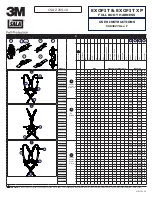
8
4. Remove clevis pin from the bottom bearing and press it from the
inside out through the newly drilled hole. Slip the bearing on the rod
portion of the attachment over the clevis pin and secure it with the
stay ring
(Fig. 17)
.
5. Ensure the rod portion is attached to the device. Slip the fabric loop over
the tibial extension of the device with the pad on the inside of the device.
6. Re-apply ski boot, slide the tube and rod portions of the attachment
together by lowering the device down on the boot, be sure the tube
portion of the attachment passes through the fabric loop between the
buckles,
(Fig. 18)
and firmly place the device over the leg and apply it
according to the standard fitting instructions
(Fig. 19)
.
Note:
For non-skiing usage, the rod portion of the attachment can be
unbolted from the device using the 1/8” (3mm) hex key provided. The
buckle system is attached via a hook-and-loop closure for easy removal.
A separate pad is provided with hook-and-loop fastener for attachment to
the brace in place of the buckle system. To adjust the amount of internal
or external rotation allowed by the ski boot attachment, loosen or tighten
respective buckles.
Device Application with Flexion Stop Kit
1. Set flexion angle using the included goniometer. The holes are
positioned in approximately 10–14° increments with
“A”
at
approximately 0° and
“I”
approximately equal to 90°.
2. Place the slotted screw on outside of plate in the desired flexion angle
and attach to the roller on the inside of the hinge plate and tighten. If
needed use one or more washers to ensure that the roller sits in
position on the frame.
3. Repeat the same process for the other side.
4. Check the angle and that the rollers are engaging nicely with the hinge
arms. If required the flexion stop plate can be contoured to optimize
positioning.
5. Apply the device according to the device application procedure.
Device Adjustments
Range of Motion (ROM) Adjustment
The device comes with a 5-10° extension stop installed and includes the
following additional stops:
0°, 5–10° (installed), 10–20°, 20–30°, and 30–40°
(Fig. 20)
1. Remove the Condyle Pad from the hinge.
2. Use a short size 2 Philips head screwdriver to remove the screw
securing the extension stop
(Fig. 13)
.
3. Remove the extension stop out of the hinge.
4. Select the desired extension stop and place the stop into the hinge
from the back with the small lip facing down
(Fig. 14)
.
5. Position the hole in the extension stop with the screw hole in the
hinge plate. Re-insert the screw and fasten. Making sure to not
overtighten.
6. Replace the condyle pad.
7. Repeat this procedure for the opposite hinge.
Note:
Ensure the same extension stop is used for both hinges.
How to Replace or Move the Field-Serviceable D-Rings
The field-serviceable D-Rings can be changed from internal to external
configuration in case of discomfort or replaced if a D-Ring is broken. If
the D-Rings are riveted onto the device, please reach out to Customer
Service or CTi distributor for assistance.
Содержание CTI CUSTOM
Страница 1: ...Instructions for Use CTI CUSTOM CTI OA...
Страница 3: ...3 1 E A B C D 2 3 4 5 6 7 8 9...
Страница 4: ...4 10 12 14 16 18 11 13 15 17 19...
Страница 5: ...5 20...
Страница 40: ...40 1 CTi Custom CTi OA CTi OA 1 2 90 2 3 CTi A 3 4 3 5 6 11 12 7 4 8 C D 9 D 10 E...
Страница 41: ...41 ACL 1 2 D 3 PCL 1 PCL 2 3 PCL PCL 1 2 15 13 mm 3 3 16 5 mm 16 4 17 5 6 18 19 1 8 3 mm...
Страница 43: ...43 4 D 5 Pro Sport 6 1 80 2 ssur ssur ssur...
Страница 68: ...68 6 7 D D D D CTi 1 1 5 D 6 2 D D 8 3 D D 9 4 D 5 2 Pro Sport 6 1 80 2 ssur ssur 1 3 5...









































